A large number of articulation markings found in wind music have long seemed nebulous directions as to how the music should be performed. In his excellent book, Effective Performance of Band Music (Southern, 1972), W. Francis McBeth devotes one complete chapter to the responses from American composers and conductors to a survey regarding these five articulation markings:

The responses were so interesting and enlightening that I decided to continue this research. The new survey was very similar to McBeth’s. It asked for general definitions of four different but equally ambiguous articulations.
Twenty distinguished American composers and conductors received a copy of the survey and were asked to respond to the following questions:
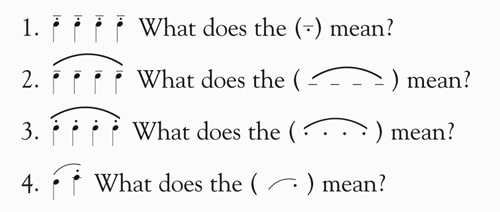
Additional comments were also welcomed.
Some of those surveyed wrote back saying that they found it impossible to respond. One reason given was that it was not possible to interpret the markings without seeing the specific musical example from which the articulation was taken, because the interpretation is dependent on the style of the period and the tradition of the composer.
Here are the interpretations offered by the seven musicians who were able to respond.
1. How do you interpret ?

Keith Brion: Three-fourths of the normal value, unended release (no mark on release).
Arnald D. Gabriel: The tenuto implies holding the note its full or slightly longer than its full value. This will depend on how rhythmic the accompaniment is. The dot indicates a slight space between the notes. I firmly believe that we in wind performance should borrow the down bow marking (≥) to make this articulation clear from an audible and visual standpoint. Each note is attacked with the down bow held as long as possible without diminuendo and the bow quickly retaken for the next and similarly played note. This example is especially effective for young players.
Karel Husa: I think of these attacks as long quarter notes (expressed by the tenuto mark) with little staccato accents. They will, however, be detached from each other; otherwise said, the player will attack the note as if it were a staccato marking only, but will hold the note nearly as long as a quarter note with the shortest possible breaks between them. A possible variation of the notation could be:
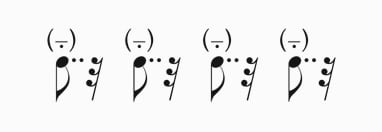
Ronald LoPresti: I have never used this. The two marks of tenuto and staccato seem to cancel each other.
Weston Noble: It is very difficult to explain these markings verbally. One almost has to hear them in rehearsal and then adjust the player’s style accordingly. This first one is unusually difficult, and to be honest with you I do not take it very seriously. I interpret it as a half-staccato, half-marcato – a slight detachment or a broad staccato. One must first determine the general overall style of the selection and adjust from there.
Vincent Persichetti: There should be some pressure (slightly accented) and slightly separated.
H. Robert Reynolds: These have slight separation but are basically long notes.
2. How do you interpret ?

Keith Brion: This is a du articulation begun with a too. The note values sound almost too long for the rhythm. The feeling is like that of full string bows. The slur indicates a strong phrasing connection.
Arnald D. Gabriel: I would assume that this articulation is to be used on different pitches because a repeated pitch with this marking would result in a sustained whole note. If there is no rhythmic pulse the slurred notes can be held longer than usual. Even though more difficult, the notes can be held longer, even with a rhythmic pulse, but great flexibility and sensitivity would then be required in the accompaniment. This articulation is used often in operatic repertoire for a dramatic effect.
Karel Husa: I assume that this articulation is used mainly in slow or moderate tempos. The dash and slur marking, it seems to me, came into wind phrasing from string bowing called louré, meaning a stroke which slightly separates the notes on one bow (thus the slur). Perhaps it could mean the same for winds: to separate the notes very slightly and in a sensitive espressivo way on one uninterrupted breath. It has been used by composers in very delicate accompaniments and sometimes even in very expressive melodies. By the slur, the composer also meant to express that the notes are not independent, but that they relate to each other.
Ronald LoPresti: Hold each tone for its full value, touching each with the tongue lightly.
Weston Noble: This should be a legato, but with a slight feeling of detachment between notes. The notes are played long, but not with a full legato, and yet with more weight than a normal legato.
Vincent Persichetti: Play this with some pressure (slightly accented) and smoothly phrased (sustained).
H. Robert Reynolds: There should be connection with pulsation on each note produced mostly with the breath.
3. How do you interpret ?

Keith Brion: Slightly shorter than the first articulation. The notes have half the normal value, but with a phrasing connection across each note, regardless of separation. Think of each note as having an unended release.
Arnald D. Gabriel: This is one of the most effective articulations available in the wind repertoire, and in my view it is not used often enough. Once again I would like to borrow from string bowings, not because winds should try to sound like strings, but what happens with the bow on the string is obvious whereas what happens in the diaphragm, lungs, and mouth of the wind player is not so obvious. In string playing, this articulation is referred to as louré bowing and was developed during the Romantic period to produce a pulsating, almost passionate kind of playing. The tempo is usually fairly slow. The violinist plays all four quarter notes in one bow on one pitch. To identify the quarter notes a slight pressure is applied as the bow is being drawn so that there is no break in the sound. Of course, I have heard violinists argue over this articulation, but it certainly results in a smooth, long-line, connected playing. Wind players should merely attack the note. To identify succeeding pitches they should create a pulsation by using the air but absolutely no tongue.
Karel Husa: The slur here also expresses a relationship between the slurred notes, but the notes are to be played shorter than in the second articulation. Normally, we say that a note with a point is shortened approximately to its half value ![]() in this case), but this again varies with the tempo; when faster, the note will be even longer than half of its value. I would recommend not breathing within the slurs.
in this case), but this again varies with the tempo; when faster, the note will be even longer than half of its value. I would recommend not breathing within the slurs.
Ronald LoPresti: Half staccato. Articulate each tone lightly with space between each quarter. This is usually played this way: ![]()
Weston Noble: A staccato, but yet a slight feeling of legato on each note. This should be the same as in articulation number 2, but in reverse – notes played short, but not as short as a full staccato and with less weight than a normal legato.
Vincent Persichetti: There should be a slight separation between tones, not accented, but liquid.
H. Robert Reynolds: Think of this as separation, generally with lightness. Sometimes the slur marking is used as a phrase marking.
4. How do you interpret ?

Keith Brion: The last note is half value with unmarked release. Usually this ending has less pressure on the second note and less weight of tone.
Arnald D. Gabriel: Because the second note has a ledger line through it and seems to be higher in pitch, the player slurs from the first to the second, making the second note shorter than the first. How short depends on the style. For an upward interval of this kind it is almost always artistically correct to make a diminuendo to the second note.
Karel Husa: I explain this example perhaps in another notation:

As in articulation no. 3 the point on the second note would shorten it to approximately half its value, but this depends on the speed of the music. There has been no clarity as to this staccato second note: should it be slightly accented as staccato notes usually are, or should it be without an accent, with the first note heavier and the second a light resolution? This depends on many factors such as the beat (in Classical music) on which it is written. If it is on a first and second beat in a moderately fast 3/4 meter, the effect will be stronger-lighter, but if it falls on the third and first beat in the same meter, it will sound lighter-heavier. Some modern composers have indicated an accent (>) together with the point, when they actually wanted that short note to be strong; on the other hand, when no accent was written, the note is to be played lighter than the first one. I think that composers rarely take the time to write out an eighth note and a rest and simply put a dot on the quarter note.
Ronald LoPresti: The second tone is touched lightly with the tongue, but is of a shorter duration than notated in order to prepare the tongue for the next attack.
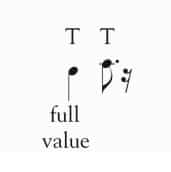
Weston Noble: There should be an easy release of the note, shorter than a normal quarter, but not a short staccato release – a modified staccato release.
Vincent Persichetti: This indicates a smooth phrase leading to a shortened and slightly tongued tone.
H. Robert Reynolds: The second note is released, but not articulated.
Additional Comments
Keith Brion: There are three staccato articulations:
TooT = ended staccato
Too = unended staccato
Toot = lightly clipped
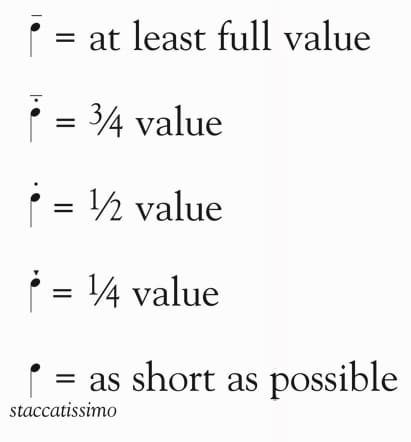
Arnald D. Gabriel: Notation and articulation markings are at best arbitrary, nebulous, and inadequate. They mean different things to different composers, conductors, and players. Additionally, to take a group of notes out of context compounds the problem because the style and tempo of the piece is unknown and can and does affect the interpretation. Finally, there is no definitive interpretation of any phase of the musical art, because music is an art, not a science, and is therefore subject to very personal considerations. With these thoughts in mind the preceding is my humble approach to the problems presented.
Karel Husa: Many markings, including the above ones, depend on numerous factors, among them the speed of the music (the same notation will sound differently in a lyrical, emotional passage than it would in a scherzo-like or satirical phrase). The modern composers were aware of some of the inadequacies of the notation and tried to be as precise as possible. I cite Stravinsky, Bartok, Webern, Berg, and Prokofiev; their scores, together with many others, are notated nearly as closely as possible to avoid any doubt. As far as older music is concerned, a knowledge of the common practice during Baroque, Classical, and Romantic music is necessary to solve these interpretative problems in different circumstances.
Ronald LoPresti: Articulations 1, 2, 3, and maybe 4 originated from concepts of bowing stringed instruments.
All upbows with a slight break between each tone:
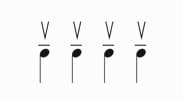
Group staccato: All upbows with definite separation between each tone:
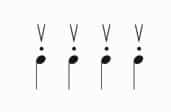
H. Robert Reynolds: Articulations 1, 2, and 3 are often used by composers who are writing string music. These are generally string bowing and articulation markings, thus:
Articulation 1 is a detaché bowing or separate bows on the string with slight separation.
Articulation 2 is generally played with a louré bowing with all four notes on the same bow with a slight pulsation on each note.
Articulation 3 is generally off-the-string bowing or the same bow stroke.
I t would also be absolutely essential to know the context in which these were used and to know the dynamic and speed of the selection or passage. All articulation markings are subject to interpretatior based upon the music and other instruments play-ing. It is also imperative to know the composer and his history of using these markings. Even a commonly used marking such as an accent (>) sounds different in Haydn, Beethoven, Brahms, and Stravinsky. To isolate these markings for a definitive statement is to me impossible.
Gary Stith taught at Holland (New York) Central High School at this article’s time of publication. he is currently professor and coordinator of music education at the Greatbach School of Music at Houghton College.